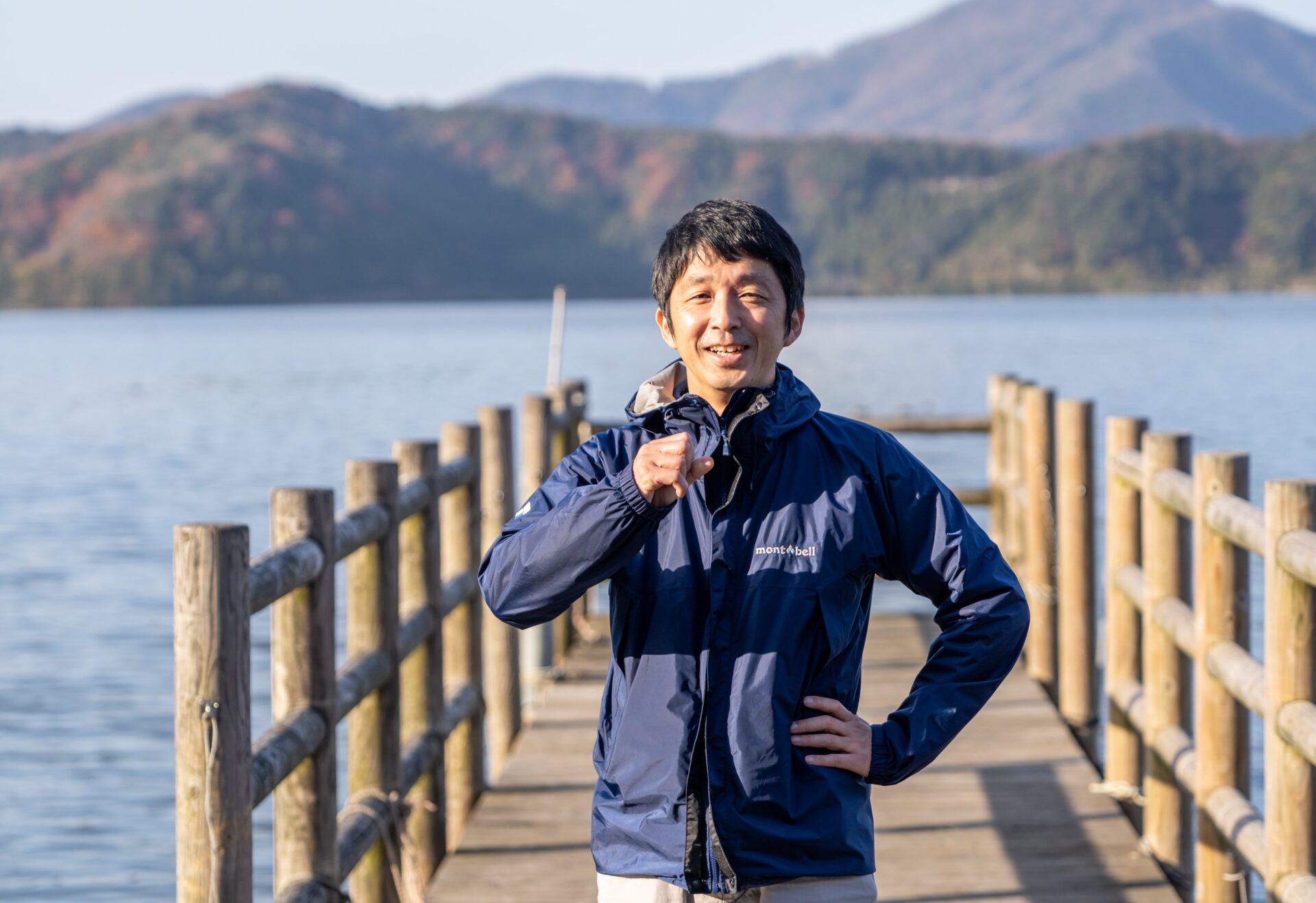
Fostering a Harmonious Relationship Between Nature and Humans: Sharing the Sustainable Value of Satoumi from Mikata Five Lakes

阪野 真人
Masato Banno
Mikata Five Lakes [Fukui]
Masato Banno
Representative Director of the General Incorporated Association Switch Switch, born in Aichi Prefecture. Specializes as an outdoor guide, having been involved in nature conservation and community development activities in Hokkaido for many years. In 2016, motivated by the desire to raise children in his wife's hometown in Fukui Prefecture, he moved to Wakasa Town, Mikatakaminaka District, Fukui Prefecture, as part of a regional revitalization cooperation team.
With the philosophy of creating towns where residents want to continue living, he actively engages in a wide range of activities as the Representative Director of the General Incorporated Association "Switch Switch." These activities include community revitalization projects, the development of various nature experience programs, the operation of "Cafe Stripes" attached to the Fukui Prefectural Varve Museum, and initiatives to increase the number of migrants.
Registered under the Ramsar Convention, the beautiful lakes and the boat houses with thatched roofs dating back to the Edo period... The Mikata Five Lakes area, spanning across Mihama Town and Wakasa Town in Fukui Prefecture, is a landscape filled with beautiful nature and traditional culture. Banno Masato, Representative Director of the general incorporated association Switch Switch, is actively engaged in various local activities such as food production, development of products utilizing local specialties, establishment of nature experience programs, and management of camping sites. He discusses the culture and history rooted in the Mikata Five Lakes and the significance of continuing to convey it.
The Formative Experience of Witnessing the Loss of Natural Environment
“I was born and raised on the outskirts of Nagoya City in Aichi Prefecture, in a house surrounded by woods,” says Banno Masato. He spent his childhood in a particularly rich natural environment, even within the densely populated Nagoya City. However, things began to change at a certain point.
“With the construction of the loop line, local residents had to relocate. When I was in high school, it was our house’s turn to move. Subsequently, the hill behind our house where I used to play and make secret bases as a child, and the field where my friends and I enjoyed playing baseball, were redeveloped one after another.”
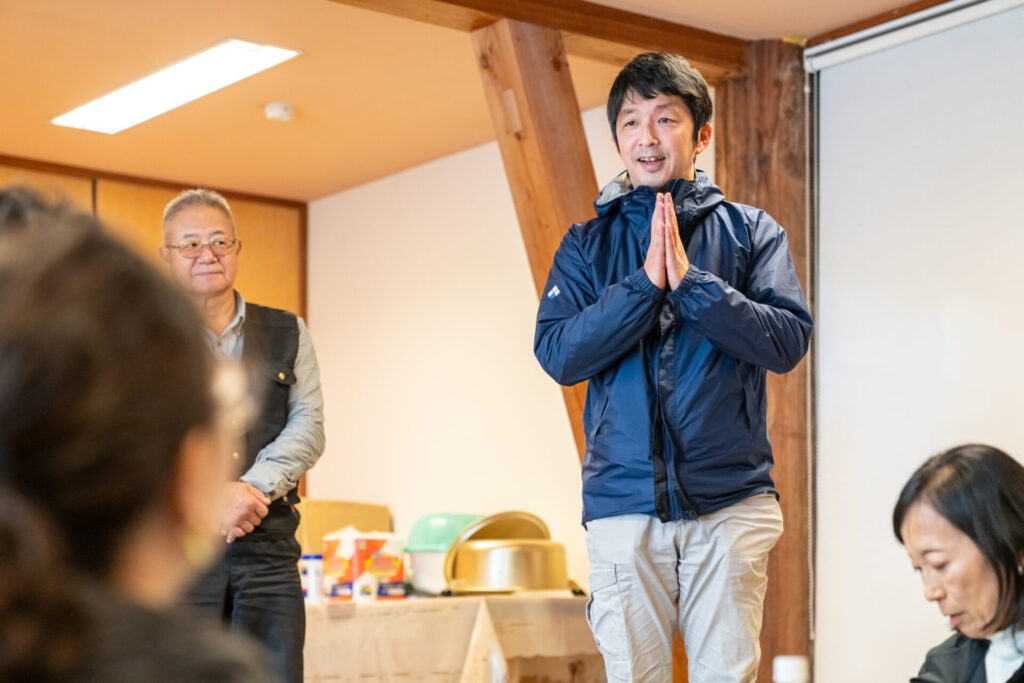
His fond memories were etched in natural landscapes that vanished due to urbanization. This experience left a deep imprint on Banno. His choice of career path after graduating high school was also influenced by these experiences.
“Having witnessed the loss of the surrounding natural environment firsthand, I decided to work in a field that would protect nature. Rather than going to university, I wanted to start working in society as soon as possible, so I deliberately focused on a vocational school. Around that time, I was reading a book by C.W. Nicol, a globally renowned environmentalist who loved Japan’s nature, and I found a mention at the end of the book about a vocational school in Tokyo where he would become a deputy principal. That moment, I decided to enroll there.”
Banno enrolled in the Tokyo Environmental Engineering vocational school, which has produced many individuals active in fields such as nature guiding and children’s nature experience projects.
“C.W. Nicol went to a forest in Nagano Prefecture where he was working on restoration himself to survey wildlife, and if a cockroach appeared during a lesson, it would turn into a class about the ecology of cockroaches on the spot. Filled with unique teachers and lectures, it was a very fulfilling experience.
What was significant during my student life was the development of a vision of making a living from nature. I learned that there are various options for working with nature. Back then, when I said I wanted to work with nature, people would mockingly ask if I intended to become a lumberjack. Perhaps the notion of ‘caring for nature’ and ‘working’ were considered separate. However, as I observed the career paths of seniors, I realized that there were indeed various options, such as becoming a nature guide or engaging in children’s nature experience projects. Being exposed to the diversity of ways to live with nature was a great treasure.”
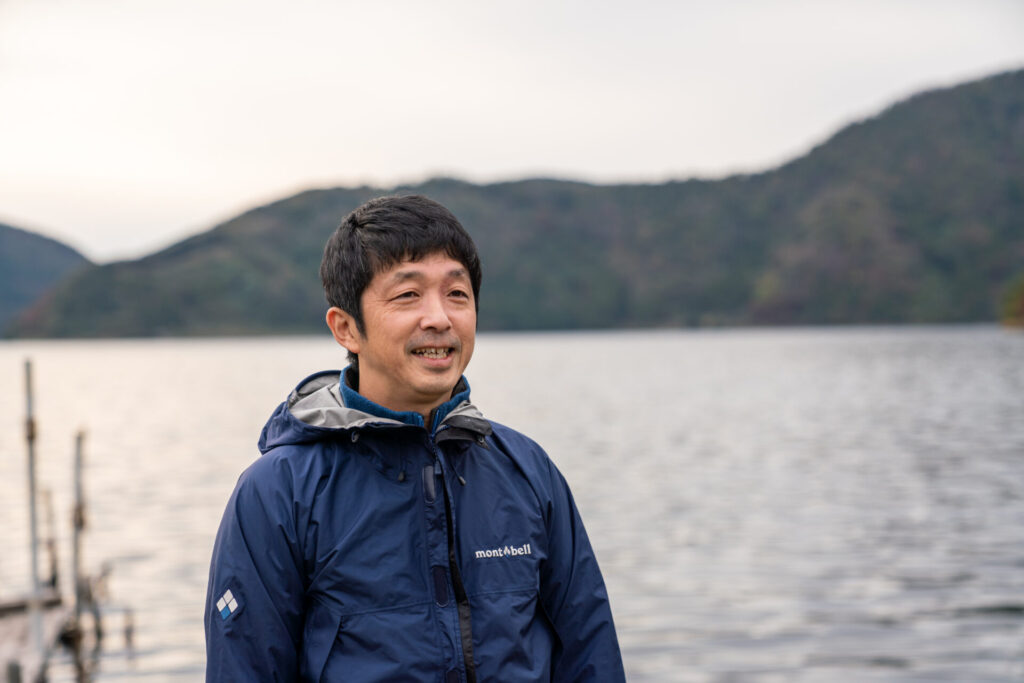
After graduating, Banno spent a year in New Zealand, a mecca for whale watching, using the Working Holiday program, and worked as a kayak guide in Fukui Prefecture. Later, at the invitation of a classmate from his vocational school days, he joined an environmental conservation organization active in a Ramsar Convention-registered wetland in Hokkaido, laying the foundation for his career.
“In the vast area, the ephemeral beauty of flowers blooming all at once during the brief summer was very characteristic of the wetland. However, there were many challenges, such as littering and land reclamation. ‘How can we connect this wetland to the future in a sustainable way?’ I pondered while creating and guiding tours to convey its charm, and working on product development with local dairy farmers and fishermen.”
All for the Love of Mikata Five Lakes
Later, considering the environment for raising children, Banno moved to his wife’s hometown, Wakasa Town in Fukui Prefecture, where the ‘Mikata Five Lakes,’ also registered under the Ramsar Convention, are located. Not only was it an opportunity to utilize his career experience, but the nature of Wakasa Town was also a key factor in their decision to move.
“While I like the grand nature of Hokkaido, encountering the nature of Wakasa Town made me realize that what suits me best is the traditional original landscape rooted in Japan. I really like the Mikata Five Lakes area, where you can find precious thatched-roof boat houses, as if you’ve stepped into the world of old tales. Actually, Wakasa Town was where I lived when I worked as a kayak guide. Even when I was working in Hokkaido, I often stayed in Wakasa during the off-season long holidays.”

After moving, Banno worked as a regional revitalization corporation team member in Wakasa Town for three years. In 2018, he co-founded the general incorporated association Switch Switch with local colleagues, launching various projects such as food production, merchandise development, establishment of nature experience programs, and support for potential migrants.
“We undertake various initiatives, but at their core is the perspective of ‘What is necessary to increase the fans of the Mikata Five Lakes area?’ The reason is, when people come to love something, they wouldn’t think of harming it. So, we constantly think about ‘How can we make people love the Mikata Five Lakes?'”
One of Banno’s initiatives to make people love the Mikata Five Lakes is the experience of the traditional fishing method, ‘tataki-net fishing,’ conducted by local fishermen.
“Tataki-net fishing is a traditional fishing method that has been practiced for over 400 years since the Edo period(1603-1868), where fish like carp and crucian carp are driven into nets by beating the water surface with bamboo. This fishing method is actually very sustainable. Unlike methods that catch fish in large quantities at once, there is no overfishing. Otherwise, it wouldn’t have continued for over 400 years.”

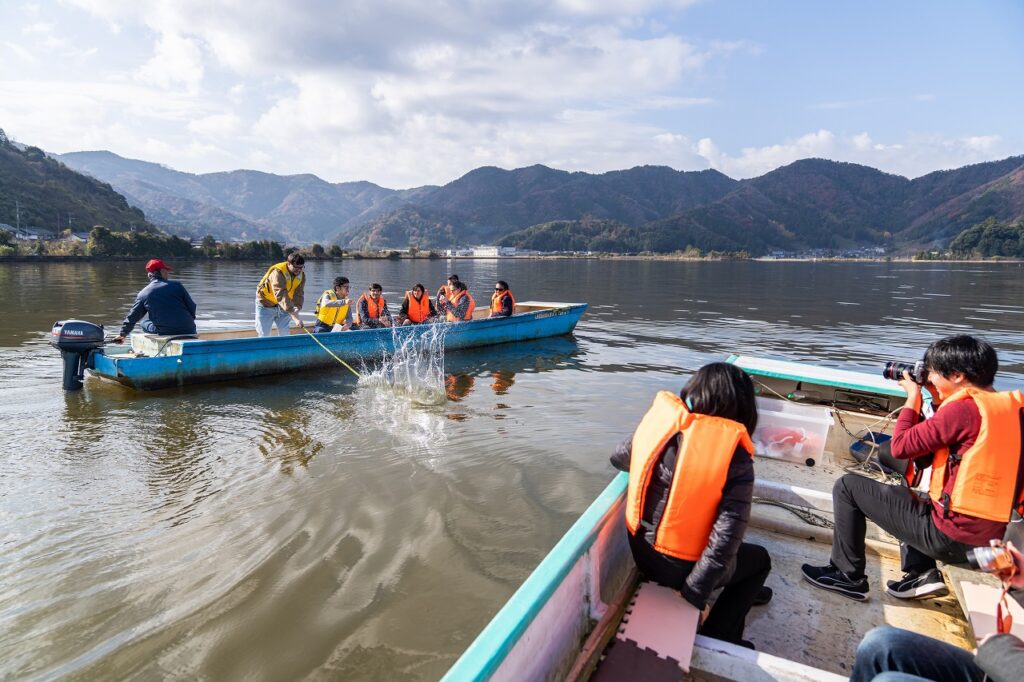
Furthermore, the Mikata Five Lakes area is historically significant. Conveying the depth of its history is one of Banno’s initiatives.
“Strata called ‘varves,’ which are layers formed by various conditions such as terrain and crustal movements accumulating over about 70,000 years, have been discovered at the bottom of Suigetsu Lake, one of the Mikata Five Lakes. These varves serve as an international standard for chronological dating in archaeology, and such precise varves spanning such a long period are found only in this region. Moreover, Jomon period archaeological sites dating back about 10,000 years have been excavated in this area. This means that the Jomon people also lived in this landscape. Conveying the depth of this history is my mission.”
Rather than telling history stiffly, Banno hopes to have visitors immerse themselves in the beautiful scenery of the Mikata Five Lakes while savoring history through their senses. This sentiment led to the operation of a cafe attached to the Fukui Prefecture Varves Museum, embodying Banno’s approach. Named ‘Cafe Shima’ meaning ‘Varve,’ offers a space where visitors can contemplate the unique ‘varves’ of the area while enjoying views of the Mikata Five Lakes.
For a Sustainable Intersection of Nature and Humanity
“The Mikata Five Lakes area is simply beautiful. Not only the view of the five lakes from the observatory but also the Sea of Japan, the morning sun, the sunset, and the starry sky are breathtaking. And it retains the traditional original landscape of Japan. I really love this place,” says Banno. His desire to preserve the scenery of this region is strong.
“The landscape before us is the result of a long history of nature forming and human activity intertwining. With that in mind, I feel that every part of the scenery that enters my field of vision is precious and worth cherishing. However, if the balance between nature and humans is disrupted, the scenery will also be damaged. That’s why I think it’s important to continue practicing and exploring how satoyama(countryside mountains) and satoumi(countryside sea) can intersect in a sustainable way between people and the natural environment.”

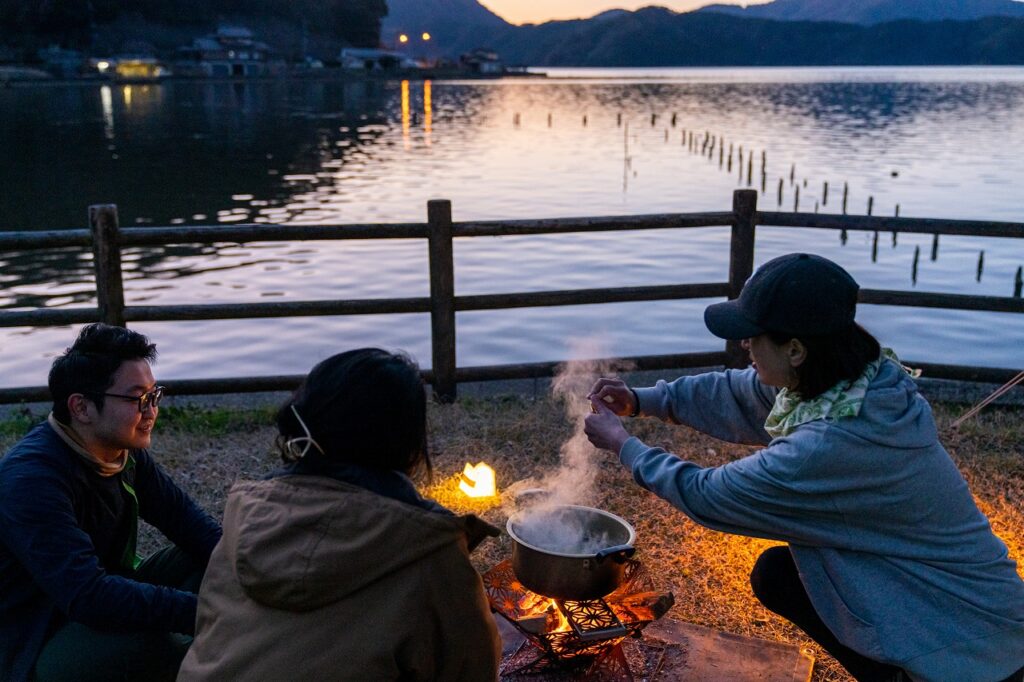
“Connecting with people is indispensable for conveying the landscape of the Mikata Five Lakes to the future,” Banno emphasizes.
“Thinking and talking together, planning, and practicing how to use resources without damaging the environment but also protecting our livelihoods is crucial. In the Mikata Five Lakes area, the number of people conveying the value of this region has been increasing, through operating campsites on the lakeshore and conducting guide tours such as kayaking. Together with these people and the fishermen practicing tataki-net fishing, we discuss the significance of conveying sustainable traditional fishing methods, ways to utilize the caught carp and crucian carp, and are moving towards the operation of experience contents and product development such as canned goods.
In addition to creating these businesses, we have also had many discussions with fishermen about ‘how we can return to a natural environment where rivers and lakes are filled with fish and the water is clear, just like in the past.’ We intend to continue facing the Mikata Five Lakes area to maintain a good relationship between nature and humans.”
The Landscape Woven by Nature and Humans of the Mikata Five Lakes
The Mikata Five Lakes have varves that record about 70,000 years of history, archaeological sites that convey the lives of Jomon people from about 10,000 years ago, and the tataki-net fishing method that has been passed down for over 400 years. We cannot let the history and culture represented by these be interrupted. I want to convey their value and charm and pass them on to the next generation.
Writer’s Thoughts:
“The fact that tataki-net fishing has continued for over 400 years because it is a sustainable fishing method particularly left an impression on me. Rather than just thinking of it as a ”tradition,” find the reasons and values behind the traditions being passed down. This perspective may also be useful for various activities aimed at connecting the past to the future.”
